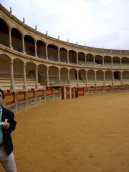| Introduction - Spain: |
| Location - Spain: |
| People - Spain: |
| Government - Spain: |
| Economy - Spain: |
Economy overview | The Spanish economy boomed from 1986 to 1990 averaging 5% annual growth. After a European-wide recession in the early 1990s, the Spanish economy resumed moderate growth starting in 1994. Spains mixed capitalist economy supports a GDP that on a per capita basis is 80% that of the four leading West European economies. The center-right government of former President AZNAR successfully worked to gain admission to the first group of countries launching the European single currency (the euro) on 1 January 1999. The AZNAR administration continued to advocate liberalization, privatization, and deregulation of the economy and introduced some tax reforms to that end. Unemployment fell steadily under the AZNAR administration but remains high at 8.1%. Growth averaging 3% annually during 2003-06 was satisfactory given the background of a faltering European economy. The Socialist president, RODRIGUEZ ZAPATERO, has made mixed progress in carrying out key structural reforms, which need to be accelerated and deepened to sustain Spains strong economic growth. Despite the economys relative solid footing significant downside risks remain including Spains continued loss of competitiveness, the potential for a housing market collapse, the countrys changing demographic profile, and a decline in EU structural funds. |
|
Gdp purchasing power parity | $1.109 trillion (2006 est.) |
|
Gdp official exchange rate | $1.084 trillion (2006 est.) |
|
Gdp real growth rate | 3.9% (2006 est.) |
|
Gdp per capita ppp | $27,400 (2006 est.) |
|
Gdp composition by sector | agriculture: 3.9%
industry: 29.4%
services: 66.7% (2006 est.) |
|
Labor force | 21.77 million (2006 est.) |
|
Labor force by occupation | agriculture: 5.3%
industry: 30.1%
services: 64.6% (2004 est.) |
|
Unemployment rate | 8.1% (October 2006 est.) |
|
Population below poverty line | 19.8% (2005) |
|
Household income or consumption by percentage share | lowest 10%: 2.8%
highest 10%: 25.2% (1990) |
|
Distribution of family income gini index | 32.5 (1990) |
|
Inflation rate consumer prices | 3.5% (2006 est.) |
|
Investment gross fixed | 29.4% of GDP (2006 est.) |
|
Budget | revenues: $488.2 billion
expenditures: $475.3 billion; including capital expenditures of $12.8 billion (2006 est.) |
|
Public debt | 39.9% of GDP (2006 est.) |
|
Agriculture products | grain, vegetables, olives, wine grapes, sugar beets, citrus; beef, pork, poultry, dairy products; fish |
|
Industries | textiles and apparel (including footwear), food and beverages, metals and metal manufactures, chemicals, shipbuilding, automobiles, machine tools, tourism, clay and refractory products, footwear, pharmaceuticals, medical equipment |
|
Industrial production growth rate | 0.6% (2006 est.) |
|
Electricity production | 263.3 billion kWh (2004) |
|
Electricity consumption | 241.8 billion kWh (2004) |
|
Electricity exports | 11.4 billion kWh (2004) |
|
Electricity imports | 8.3 billion kWh (2004) |
|
Oil production | 31,250 bbl/day (2004 est.) |
|
Oil consumption | 1.573 million bbl/day (2004 est.) |
|
Oil exports | 175,200 bbl/day (2004) |
|
Oil imports | 1.714 million bbl/day (2004) |
|
Oil proved reserves | 157.6 million bbl (1 January 2005) |
|
Natural gas production | 339 million cu m (2004 est.) |
|
Natural gas consumption | 27.01 billion cu m (2004 est.) |
|
Natural gas exports | 0 cu m (2004 est.) |
|
Natural gas imports | 26.95 billion cu m (2004 est.) |
|
Natural gas proved reserves | 2.549 billion cu m (1 January 2005 est.) |
|
Current account balance | -$98.6 billion (2006 est.) |
|
Exports | $222.1 billion f.o.b. (2006 est.) |
|
Exports commodities | machinery, motor vehicles; foodstuffs, pharmaceuticals, medicines, other consumer goods |
|
Exports partners | France 18.9%, Germany 11%, Portugal 8.9%, Italy 8.6%, UK 7.8%, US 4.5% (2006) |
|
Imports | $324.4 billion f.o.b. (2006 est.) |
|
Imports commodities | machinery and equipment, fuels, chemicals, semifinished goods, foodstuffs, consumer goods, measuring and medical control instruments |
|
Imports partners | Germany 14.7%, France 13.2%, Italy 8.1%, UK 5%, Netherlands 4.8%, China 4.8% (2006) |
|
Reserves of foreign exchange and gold | $17 billion (2006 est.) |
|
Economic aid donor | ODA, $1.33 billion (1999) |
|
Debt external | $1.591 trillion (30 June 2006 est.) |
|
Currency code | euro (EUR)
note: on 1 January 1999, the European Monetary Union introduced the euro as a common currency to be used by the financial institutions of member countries; on 1 January 2002, the euro became the sole currency for everyday transactions with the member countries |
|
Exchange rates | euros per US dollar - 0.7964 (2006), 0.8041 (2005), 0.8054 (2004), 0.886 (2003), 1.0626 (2002) |
|
| Communications - Spain: |
| Transportation - Spain: |
| Military - Spain: |
This page was last updated on 16 September, 2007



